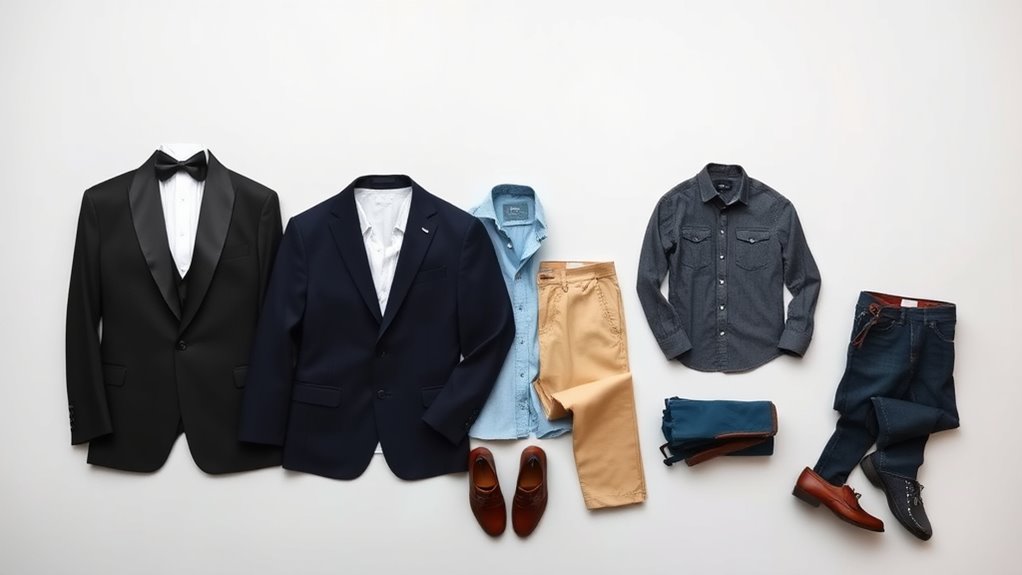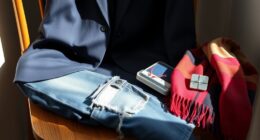Decoding dress codes from white tie to smart casual can seem tricky, but you can master it by understanding key guidelines. For formal events like white tie, opt for tuxedos and elegant accessories, keeping jewelry minimal. Semi-formal and cocktail attire call for sleek dresses or suits with polished accessories, while casual looks focus on comfort with well-fitted jeans and crisp shirts. Knowing these basics helps you dress confidently and appropriately—keep going to discover more tips to perfect your style for any occasion.
Key Takeaways
- Understand the hierarchy: White tie is the most formal, followed by black tie, semi-formal, smart casual, and casual.
- For white tie, wear a tailcoat, white bow tie, and formal accessories; for smart casual, opt for neat, relaxed pieces.
- Match accessories appropriately: minimal jewelry for formal events, statement pieces for casual settings.
- Use seasonal wardrobe tips to select suitable fabrics and layers for each dress code.
- Always consider the event’s purpose and audience to choose an outfit that is appropriate and confident.

Understanding dress codes can feel confusing, but decoding them is essential to making the right impression. Whether you’re heading to a formal wedding or a casual brunch, knowing what to wear helps you feel confident and appropriate. One key aspect often overlooked is accessory etiquette. The right accessories can elevate your outfit and show that you’ve paid attention to the details. For example, with black-tie or white-tie events, keep jewelry minimal and elegant, avoiding anything too flashy or distracting. A classic watch or simple pearl earrings work well. For less formal occasions, you can add personality with statement pieces, but always ensure they complement your overall look without overpowering it.
Accessorize thoughtfully: keep jewelry minimal for formal events, and add personality with statement pieces for casual occasions.
Seasonal wardrobe tips are equally important. Dressing appropriately for the time of year not only keeps you comfortable but also shows you understand the event’s tone. In summer, lighter fabrics like linen or cotton are your best friends, and you can incorporate seasonal colors or floral accents. Layering is crucial, so opt for a stylish blazer or shawl that you can remove if it gets too warm. During winter, focus on warmth without sacrificing style—think tailored coats, scarves, and gloves that match your outfit. For spring and fall, layering becomes even more vital, allowing you to adapt as temperatures change throughout the day.
When decoding dress codes, it’s helpful to think of your wardrobe as a toolkit. For formal events like black-tie or white-tie, invest in classic pieces that stand the test of time. A well-fitted tuxedo or evening gown is always appropriate, and accessories should be understated yet refined. For semi-formal or cocktail occasions, a sleek dress or tailored suit works perfectly. Here, you can experiment with accessories—think clutches, tie pins, or pocket squares—making sure they align with the event’s vibe. For casual or smart casual dress codes, comfort and style go hand in hand. Choose well-fitted jeans or chinos paired with a crisp shirt or blouse, adding accessories like watches or belts to polish your look.
Ultimately, decoding dress codes boils down to understanding the event’s purpose and audience. Use your seasonal wardrobe tips to stay comfortable and stylish, and keep accessory etiquette in mind to strike the right balance. Additionally, understanding the specific dress code can help you select appropriate attire that aligns with the occasion’s expectations. When you pay attention to these details, you’ll always arrive prepared, making a confident and memorable impression.
Frequently Asked Questions
How Do I Dress Appropriately for a Business Casual Event?
For a business casual event, you want to strike a balance between professional and relaxed. Opt for corporate attire like tailored slacks or a skirt paired with a neat blouse or button-down shirt. Add casual elegance with a stylish blazer or cardigan. Avoid overly casual pieces like jeans or sneakers, and keep accessories minimal. This way, you present yourself as polished yet comfortable, fitting perfectly within the business casual dress code.
What Accessories Are Suitable for a Semi-Formal Outfit?
Think of accessories as the punctuation of your outfit—they complete the sentence. For a semi-formal look, choose simple yet elegant jewelry that complements your attire. Opt for classic pieces like stud earrings or a delicate necklace, and make certain your accessory pairing isn’t overpowering. Keep your jewelry selection refined, and choose a sleek watch or a subtle clutch to add a polished touch without stealing the spotlight.
Are There Cultural Considerations in Dress Codes Worldwide?
When considering dress codes worldwide, you should be aware of cultural dress norms and global attire variations. Different cultures have unique expectations, like modesty requirements or specific colors for certain events. You’ll want to research local customs before dressing for international occasions. Respecting these cultural differences guarantees you’re appropriate and respectful, helping you avoid misunderstandings or offense. Always adapt your outfit to honor the traditions of the place you’re visiting.
How Can I Adapt Dress Code Guidelines for Different Seasons?
Think of dressing for the seasons as painting a picture; you layer and choose colors wisely. To adapt dress code guidelines, incorporate seasonal layering, such as adding a blazer or scarf in cooler months. Opt for fabric selection like lightweight cotton or linen in summer, and wool or velvet in winter. This approach helps you stay comfortable and stylish, regardless of the season’s palette.
What Are Common Mistakes to Avoid With Smart Casual Attire?
When dressing smart casual, avoid misinterpreting casual as too relaxed or overly formal. Keep your look polished but comfortable, steering clear of over accessorizing, which can seem cluttered. Stick to classic pieces like tailored trousers and a neat blouse or shirt. Don’t forget to choose appropriate footwear. Remember, the goal is a balanced, stylish appearance that’s easy to adapt for different settings, so stay refined without overdoing it.
Conclusion
Now that you’ve decoded dress codes, imagine yourself at a grand event, confidently dressed in the perfect attire. As you step through the door, the subtle nods and smiles of others confirm you’ve nailed the look. It’s like a puzzle falling into place, where understanding each code turns uncertainty into effortless style. With this knowledge, you’re ready to make a memorable impression, no matter the dress code, and enjoy every moment with confidence.









